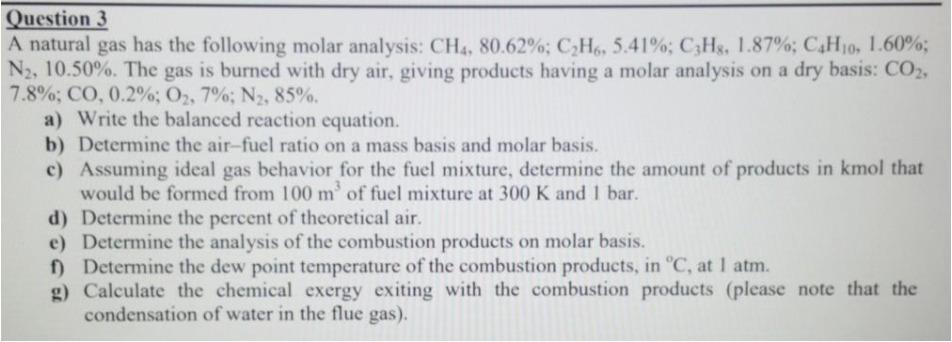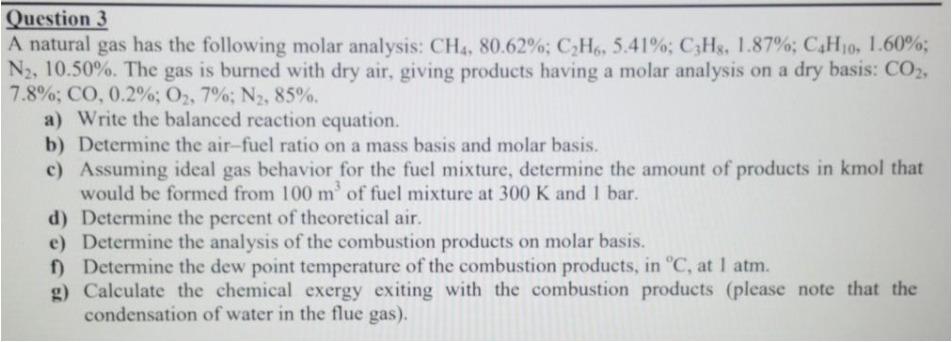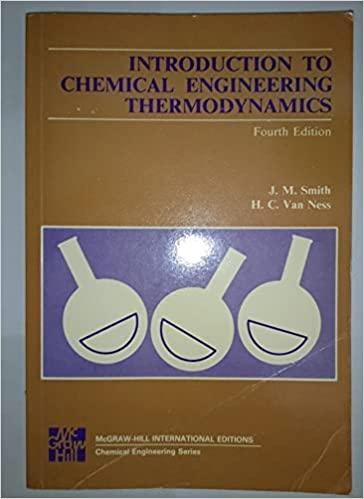

A natural gas has the following molar analysis: CH4,80.62%;C2H6,5.41%;C3H8,1.87%;C4H10,1.60%; N2,10.50%. The gas is burned with dry air, giving products having a molar analysis on a dry basis: CO2, 7.8%;CO,0.2%;O2,7%;N2,85%. a) Write the balanced reaction equation. b) Determine the air-fuel ratio on a mass basis and molar basis. c) Assuming ideal gas behavior for the fuel mixture, determine the amount of products in kmol that would be formed from 100m3 of fuel mixture at 300K and 1 bar. d) Determine the percent of theoretical air. e) Determine the analysis of the combustion products on molar basis. f) Determine the dew point temperature of the combustion products, in C, at 1latm. g) Calculate the chemical exergy exiting with the combustion products (please note that the condensation of water in the flue gas). A natural gas has the following molar analysis: CH4,80.62%;C2H6,5.41%;C3H8,1.87%;C4H10,1.60%; N2,10.50%. The gas is burned with dry air, giving products having a molar analysis on a dry basis: CO2, 7.8%;CO,0.2%;O2,7%;N2,85%. a) Write the balanced reaction equation. b) Determine the air-fuel ratio on a mass basis and molar basis. c) Assuming ideal gas behavior for the fuel mixture, determine the amount of products in kmol that would be formed from 100m3 of fuel mixture at 300K and 1 bar. d) Determine the percent of theoretical air. e) Determine the analysis of the combustion products on molar basis. f) Determine the dew point temperature of the combustion products, in C, at 1latm. g) Calculate the chemical exergy exiting with the combustion products (please note that the condensation of water in the flue gas). A natural gas has the following molar analysis: CH4,80.62%;C2H6,5.41%;C3H8,1.87%;C4H10,1.60%; N2,10.50%. The gas is burned with dry air, giving products having a molar analysis on a dry basis: CO2, 7.8%;CO,0.2%;O2,7%;N2,85%. a) Write the balanced reaction equation. b) Determine the air-fuel ratio on a mass basis and molar basis. c) Assuming ideal gas behavior for the fuel mixture, determine the amount of products in kmol that would be formed from 100m3 of fuel mixture at 300K and 1 bar. d) Determine the percent of theoretical air. e) Determine the analysis of the combustion products on molar basis. f) Determine the dew point temperature of the combustion products, in C, at 1latm. g) Calculate the chemical exergy exiting with the combustion products (please note that the condensation of water in the flue gas). A natural gas has the following molar analysis: CH4,80.62%;C2H6,5.41%;C3H8,1.87%;C4H10,1.60%; N2,10.50%. The gas is burned with dry air, giving products having a molar analysis on a dry basis: CO2, 7.8%;CO,0.2%;O2,7%;N2,85%. a) Write the balanced reaction equation. b) Determine the air-fuel ratio on a mass basis and molar basis. c) Assuming ideal gas behavior for the fuel mixture, determine the amount of products in kmol that would be formed from 100m3 of fuel mixture at 300K and 1 bar. d) Determine the percent of theoretical air. e) Determine the analysis of the combustion products on molar basis. f) Determine the dew point temperature of the combustion products, in C, at 1latm. g) Calculate the chemical exergy exiting with the combustion products (please note that the condensation of water in the flue gas)








